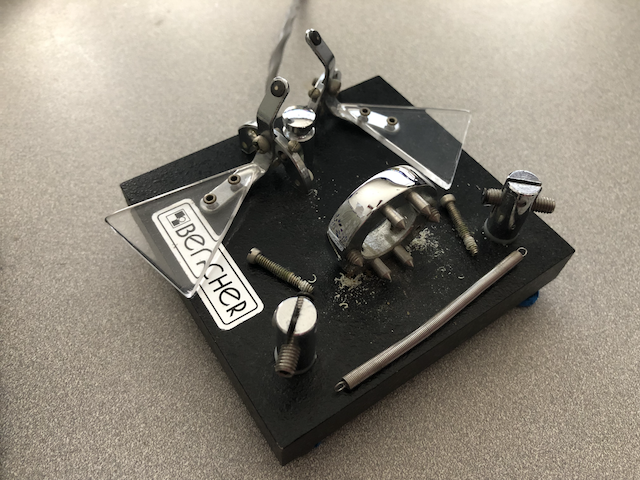This past weekend I participated in the IARU HF World Championship contest. I chuckle at the phrase “world championship” because I’m a casual contester, a Sunday driver. I took this opportunity to practice my CW operating, as I have in other contests recently. My goal this year was to make 250 QSOs to qualify for the fancy certificate. This goal would require me to be a run station: sit on a frequency, call “CQ”, and copy other stations callsigns and exchanges (sent via Morse code) as efficiently as possible. I also thought 250 QSOs would be a good goal considering that I didn’t expect to be at the radio for the entire 24 hour contest period.
In last year’s contest, I had 55 contacts over 161 minutes, yielding ~20 QSOs per hour. My error rate was 3.7%, only two bad QSOs in the log. I would guess that these are all search and pounce QSOs, judging from the low QSO rate and the low error rate. Unfortunately my notes from last year’s contest don’t go much beyond my per-band statistics while noting “allocate more time next year, run like Field Day”.
Pre Contest
I spent zero time preparing. I’m not aiming for a top honors, so nothing lost.
Contest Time
I started the contest a couple hours late after leisurely enjoying breakfast and coffee. After getting my N1MM logging software updated, I began searching and pouncing on 20m. From home, I was using my IC-7300 with a MFJ-986 tuner putting 100W into a multiband tuned doublet antenna.

When hunting, I encountered a variety of operating speeds. At times, I set the N1MM keyer as high as 35 WPM to match the pace of some fast QRQ Italian stations. I slowed down to 21 WPM for some other stations, but mostly stayed between 25-30 WPM.
I didn’t start running in the contest until midday. When running, I set the N1MM keyer to 25 WPM. I had to ask for several repeats, especially during pileups. Pileups were small, never more than ~3 stations. Throughout the day I alternated between running and search and pounce. When my run frequency got quiet, I would search and pounce, sometimes trying a new band.
During the contest, a new-to-me set of Bench BY-1 paddles caused some mischief when the dit paddle would not open, sending repeating dits. I increased contact spacing a few different times throughout the contest. Fortunately I didn’t need to use them often. After the contest, I took the paddle apart and discovered that it needs significant attention before I put it back into service.

The late afternoon brought thunderstorms through our area and provided a nice break from the contest. I operated again after things in our house quieted down for the evening. I had operated solely on 20m and up during the morning and afternoon, figuring that 40m would keep me busy during the evening. Sure enough, there was a lot of activity on 40m when I got there. I worked several stations that I had previously worked on 20m, making exchanges simpler.
My ability to copy CW waned as the evening wore on. Stations were decreasing their speed to match mine, yet I still had to ask for fills, sometimes repeatedly. I wound up crossing the 250 QSO mark shortly before 1am. I ended the contest with 270 QSOs, safely above my goal of 250.
A few things saved my bacon at various times during the contest. The first was N1MM highlighting suspect callsigns in orange. After seeing a logged contact highlighted in orange, I might listen to the station’s callsign sign again. Sometimes, I had the callsign wrong. A second lifesaver were the stations that would correct me when I copied their callsign incorrectly. Thanks! Calling stations have no incentive (points-wise) to correct a callsign incorrectly copied by a running station. I appreciate the corrections that were provided to me and returned the favor on a few occasions where my callsign was copied incorrectly.
Post Contest
Before the contest I had 70 CW DXCC entities confirmed in Logbook of the World. Three days after the contest, I’m up to 72. I hope more confirmed QSOs will trickle in the over the next week or two.
Score Summary:
Contest: IARU
Band QSOs Pts ITU HQ Pt/Q
3.5 5 9 3 1 1.8
7 37 89 12 6 2.4
14 179 635 20 17 3.5
21 42 114 12 8 2.7
28 7 29 3 1 4.1
Total 270 876 50 33 3.2
Score: 72,708
1 Mult = 3.3 Q's
Run Summary:
Internatl Amateur Radio Union HF Contest - 2022-07-09 1200Z to 2022-07-10 1200Z - 271 QSOs
K4CBW Runs >10 QSOs: for computer named: WIN11-HAM
2022-07-09 1833 - 1847Z, 14042 kHz, 12 Qs, 52.1/hr K4CBW
2022-07-09 1928 - 2005Z, 14044 kHz, 18 Qs, 29.1/hr K4CBW
2022-07-10 0156 - 0226Z, 14060 kHz, 38 Qs, 77.5/hr K4CBW
2022-07-10 0425 - 0456Z, 14039 kHz, 35 Qs, 68.0/hr K4CBW
Off Times:
Internatl Amateur Radio Union HF Contest - 2022-07-09 1200Z to 2022-07-10 1200Z - 271 QSOs
K4CBW - Off Times >= 30 Minutes
2022-07-09 1200Z - 2022-07-09 1415Z 02:16 (136 mins) (Start late)
2022-07-09 1417Z - 2022-07-09 1455Z 00:39 (39 mins)
2022-07-09 1601Z - 2022-07-09 1708Z 01:08 (68 mins)
2022-07-09 1848Z - 2022-07-09 1927Z 00:40 (40 mins)
2022-07-09 2120Z - 2022-07-10 0033Z 03:14 (194 mins)
2022-07-10 0227Z - 2022-07-10 0317Z 00:51 (51 mins)
2022-07-10 0530Z - 2022-07-10 1159Z 06:29 (389 mins) (End early)
Total Time Off 15:17 (917 mins)
Total Time On 08:43 (523 mins)
Multipliers:

Next Year
Hopefully I read this before next year’s contest. Future me:
- Pick up multipliers on 80m, but don’t linger.
- Pick up multipliers on 10m and 15m, but don’t linger.
- 20m was the money band this year.
- Make sure the paddles are working. 25 WPM was a good speed for manually sending on the IC-7300.
- Do more mid-week contests. Make casual QSOs. Practice head copy.